Business Laws Assignment: Sole Proprietorship to Company Comparison
VerifiedAdded on 2020/04/07
|9
|2300
|245
Homework Assignment
AI Summary
This assignment delves into the intricacies of Australian business laws, focusing on various business structures. It begins by examining sole proprietorships, outlining the steps required for registration and the feasibility of incorporating partners. The assignment then explores companies, highlighting their advantages, such as separate legal entity status and perpetual existence, while also acknowledging disadvantages like limited owner control and increased legal obligations. A comparative analysis of companies, partnerships, and sole proprietorships is provided, contrasting their liabilities, control structures, and suitability for different business scales. The assignment further discusses the process of incorporating additional members into a company by issuing shares and protecting personal assets through limited liability structures. Finally, it covers the reporting obligations businesses must adhere to in Australia, including Business Activity Statements, financial reporting to ASIC, and compliance with Australian Accounting Standards and the Corporations Act 2001. This assignment provides a comprehensive overview of the legal and structural considerations for businesses operating in Australia.

Running head: BUSINESS LAWS
Business Laws
Name of the student
Name of the university
Author note
Business Laws
Name of the student
Name of the university
Author note
Paraphrase This Document
Need a fresh take? Get an instant paraphrase of this document with our AI Paraphraser
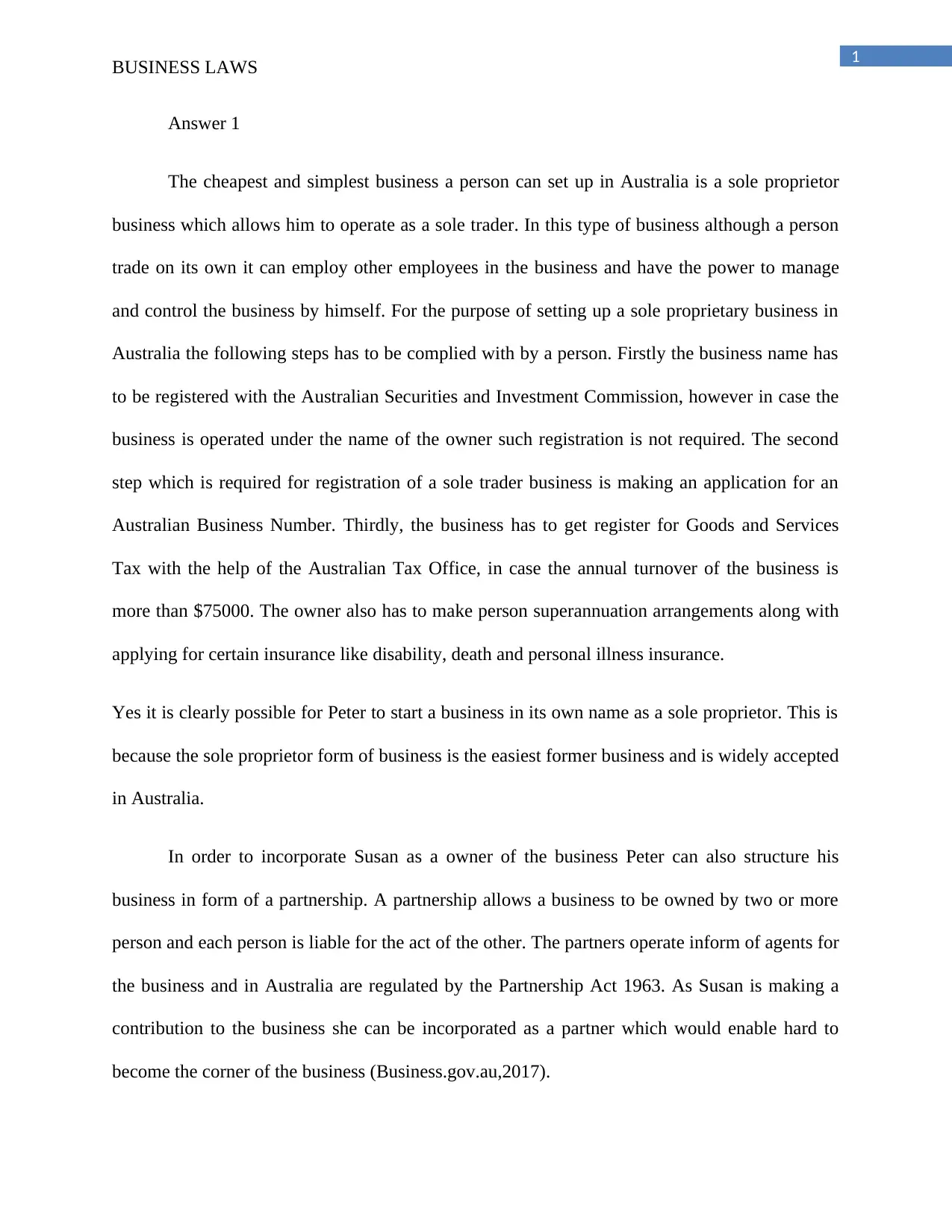
1
BUSINESS LAWS
Answer 1
The cheapest and simplest business a person can set up in Australia is a sole proprietor
business which allows him to operate as a sole trader. In this type of business although a person
trade on its own it can employ other employees in the business and have the power to manage
and control the business by himself. For the purpose of setting up a sole proprietary business in
Australia the following steps has to be complied with by a person. Firstly the business name has
to be registered with the Australian Securities and Investment Commission, however in case the
business is operated under the name of the owner such registration is not required. The second
step which is required for registration of a sole trader business is making an application for an
Australian Business Number. Thirdly, the business has to get register for Goods and Services
Tax with the help of the Australian Tax Office, in case the annual turnover of the business is
more than $75000. The owner also has to make person superannuation arrangements along with
applying for certain insurance like disability, death and personal illness insurance.
Yes it is clearly possible for Peter to start a business in its own name as a sole proprietor. This is
because the sole proprietor form of business is the easiest former business and is widely accepted
in Australia.
In order to incorporate Susan as a owner of the business Peter can also structure his
business in form of a partnership. A partnership allows a business to be owned by two or more
person and each person is liable for the act of the other. The partners operate inform of agents for
the business and in Australia are regulated by the Partnership Act 1963. As Susan is making a
contribution to the business she can be incorporated as a partner which would enable hard to
become the corner of the business (Business.gov.au,2017).
BUSINESS LAWS
Answer 1
The cheapest and simplest business a person can set up in Australia is a sole proprietor
business which allows him to operate as a sole trader. In this type of business although a person
trade on its own it can employ other employees in the business and have the power to manage
and control the business by himself. For the purpose of setting up a sole proprietary business in
Australia the following steps has to be complied with by a person. Firstly the business name has
to be registered with the Australian Securities and Investment Commission, however in case the
business is operated under the name of the owner such registration is not required. The second
step which is required for registration of a sole trader business is making an application for an
Australian Business Number. Thirdly, the business has to get register for Goods and Services
Tax with the help of the Australian Tax Office, in case the annual turnover of the business is
more than $75000. The owner also has to make person superannuation arrangements along with
applying for certain insurance like disability, death and personal illness insurance.
Yes it is clearly possible for Peter to start a business in its own name as a sole proprietor. This is
because the sole proprietor form of business is the easiest former business and is widely accepted
in Australia.
In order to incorporate Susan as a owner of the business Peter can also structure his
business in form of a partnership. A partnership allows a business to be owned by two or more
person and each person is liable for the act of the other. The partners operate inform of agents for
the business and in Australia are regulated by the Partnership Act 1963. As Susan is making a
contribution to the business she can be incorporated as a partner which would enable hard to
become the corner of the business (Business.gov.au,2017).
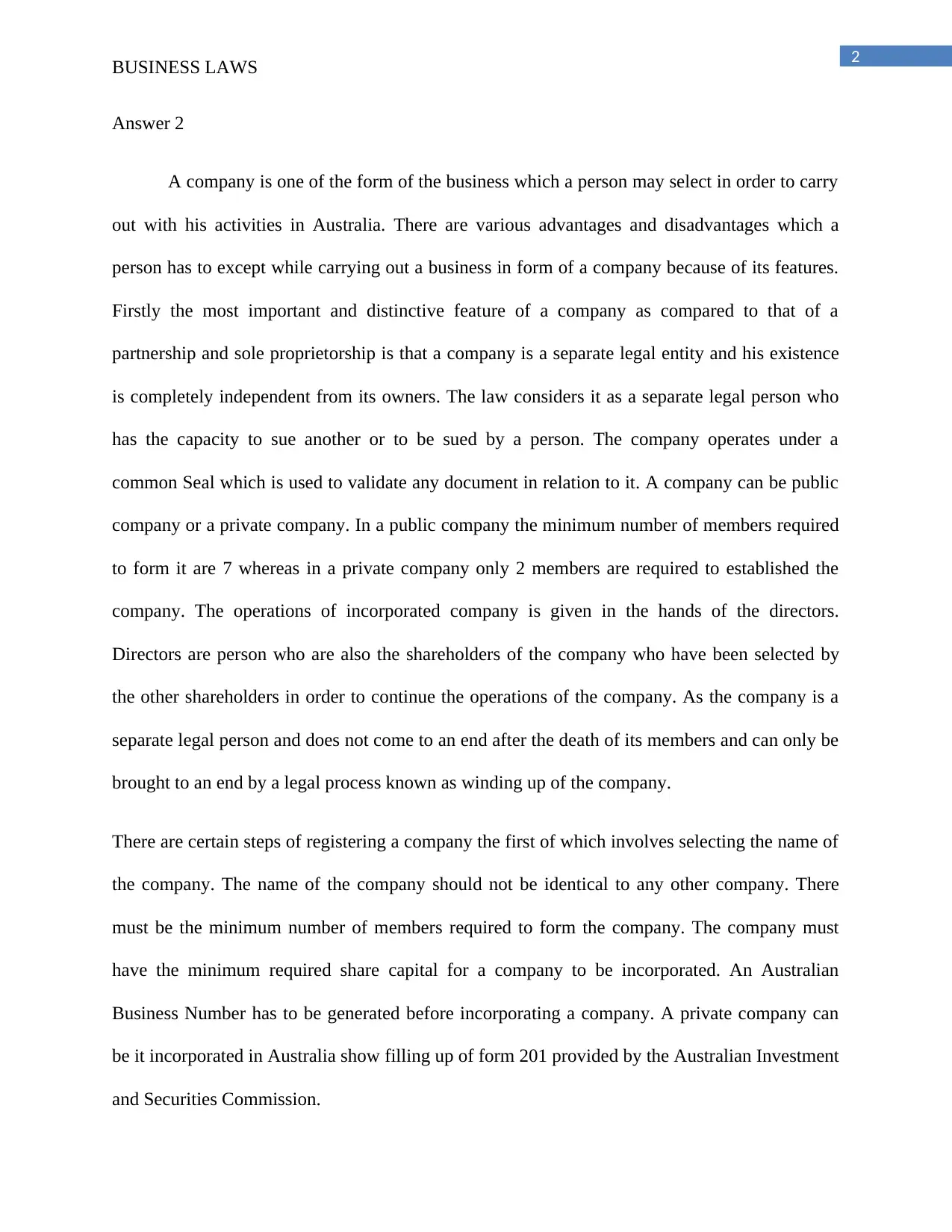
2
BUSINESS LAWS
Answer 2
A company is one of the form of the business which a person may select in order to carry
out with his activities in Australia. There are various advantages and disadvantages which a
person has to except while carrying out a business in form of a company because of its features.
Firstly the most important and distinctive feature of a company as compared to that of a
partnership and sole proprietorship is that a company is a separate legal entity and his existence
is completely independent from its owners. The law considers it as a separate legal person who
has the capacity to sue another or to be sued by a person. The company operates under a
common Seal which is used to validate any document in relation to it. A company can be public
company or a private company. In a public company the minimum number of members required
to form it are 7 whereas in a private company only 2 members are required to established the
company. The operations of incorporated company is given in the hands of the directors.
Directors are person who are also the shareholders of the company who have been selected by
the other shareholders in order to continue the operations of the company. As the company is a
separate legal person and does not come to an end after the death of its members and can only be
brought to an end by a legal process known as winding up of the company.
There are certain steps of registering a company the first of which involves selecting the name of
the company. The name of the company should not be identical to any other company. There
must be the minimum number of members required to form the company. The company must
have the minimum required share capital for a company to be incorporated. An Australian
Business Number has to be generated before incorporating a company. A private company can
be it incorporated in Australia show filling up of form 201 provided by the Australian Investment
and Securities Commission.
BUSINESS LAWS
Answer 2
A company is one of the form of the business which a person may select in order to carry
out with his activities in Australia. There are various advantages and disadvantages which a
person has to except while carrying out a business in form of a company because of its features.
Firstly the most important and distinctive feature of a company as compared to that of a
partnership and sole proprietorship is that a company is a separate legal entity and his existence
is completely independent from its owners. The law considers it as a separate legal person who
has the capacity to sue another or to be sued by a person. The company operates under a
common Seal which is used to validate any document in relation to it. A company can be public
company or a private company. In a public company the minimum number of members required
to form it are 7 whereas in a private company only 2 members are required to established the
company. The operations of incorporated company is given in the hands of the directors.
Directors are person who are also the shareholders of the company who have been selected by
the other shareholders in order to continue the operations of the company. As the company is a
separate legal person and does not come to an end after the death of its members and can only be
brought to an end by a legal process known as winding up of the company.
There are certain steps of registering a company the first of which involves selecting the name of
the company. The name of the company should not be identical to any other company. There
must be the minimum number of members required to form the company. The company must
have the minimum required share capital for a company to be incorporated. An Australian
Business Number has to be generated before incorporating a company. A private company can
be it incorporated in Australia show filling up of form 201 provided by the Australian Investment
and Securities Commission.
⊘ This is a preview!⊘
Do you want full access?
Subscribe today to unlock all pages.

Trusted by 1+ million students worldwide
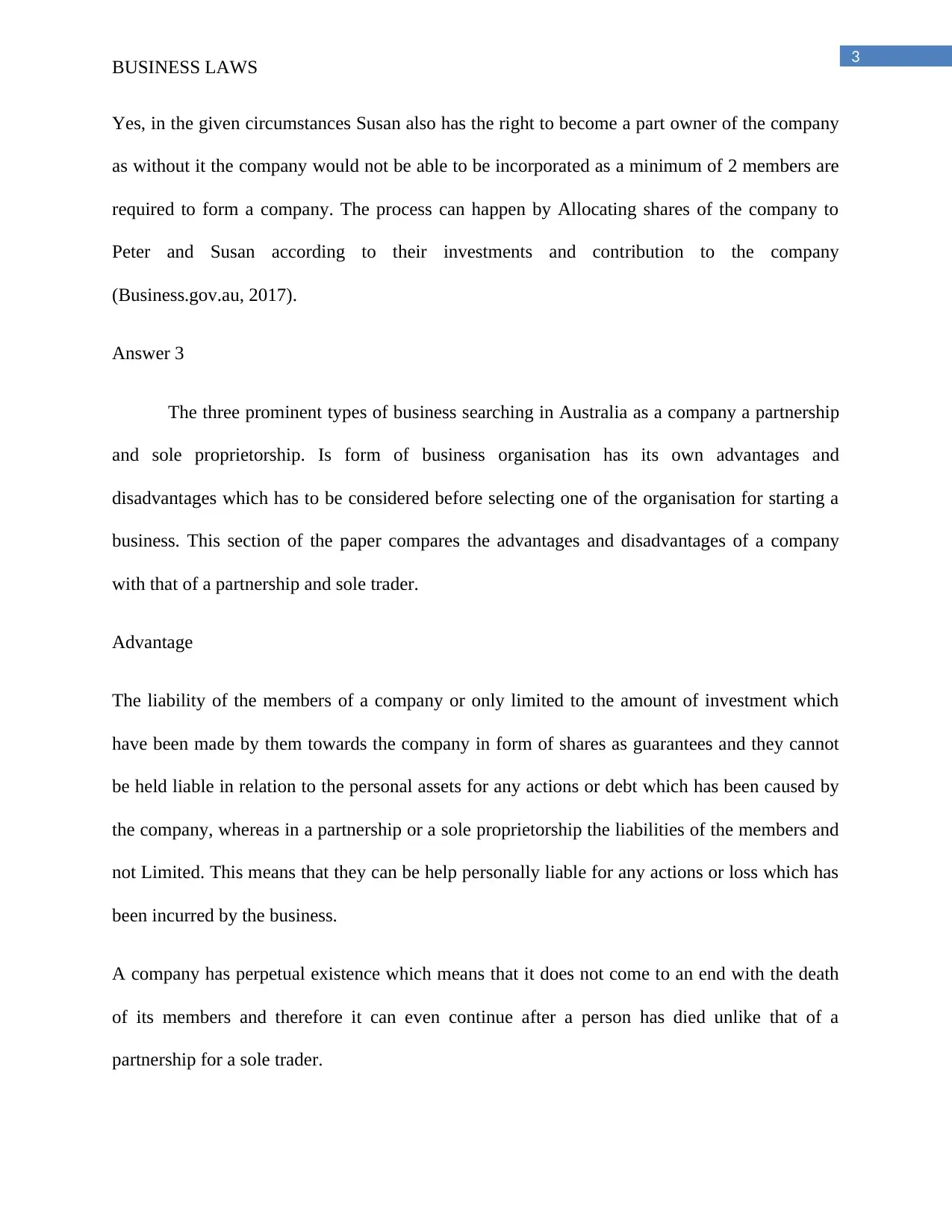
3
BUSINESS LAWS
Yes, in the given circumstances Susan also has the right to become a part owner of the company
as without it the company would not be able to be incorporated as a minimum of 2 members are
required to form a company. The process can happen by Allocating shares of the company to
Peter and Susan according to their investments and contribution to the company
(Business.gov.au, 2017).
Answer 3
The three prominent types of business searching in Australia as a company a partnership
and sole proprietorship. Is form of business organisation has its own advantages and
disadvantages which has to be considered before selecting one of the organisation for starting a
business. This section of the paper compares the advantages and disadvantages of a company
with that of a partnership and sole trader.
Advantage
The liability of the members of a company or only limited to the amount of investment which
have been made by them towards the company in form of shares as guarantees and they cannot
be held liable in relation to the personal assets for any actions or debt which has been caused by
the company, whereas in a partnership or a sole proprietorship the liabilities of the members and
not Limited. This means that they can be help personally liable for any actions or loss which has
been incurred by the business.
A company has perpetual existence which means that it does not come to an end with the death
of its members and therefore it can even continue after a person has died unlike that of a
partnership for a sole trader.
BUSINESS LAWS
Yes, in the given circumstances Susan also has the right to become a part owner of the company
as without it the company would not be able to be incorporated as a minimum of 2 members are
required to form a company. The process can happen by Allocating shares of the company to
Peter and Susan according to their investments and contribution to the company
(Business.gov.au, 2017).
Answer 3
The three prominent types of business searching in Australia as a company a partnership
and sole proprietorship. Is form of business organisation has its own advantages and
disadvantages which has to be considered before selecting one of the organisation for starting a
business. This section of the paper compares the advantages and disadvantages of a company
with that of a partnership and sole trader.
Advantage
The liability of the members of a company or only limited to the amount of investment which
have been made by them towards the company in form of shares as guarantees and they cannot
be held liable in relation to the personal assets for any actions or debt which has been caused by
the company, whereas in a partnership or a sole proprietorship the liabilities of the members and
not Limited. This means that they can be help personally liable for any actions or loss which has
been incurred by the business.
A company has perpetual existence which means that it does not come to an end with the death
of its members and therefore it can even continue after a person has died unlike that of a
partnership for a sole trader.
Paraphrase This Document
Need a fresh take? Get an instant paraphrase of this document with our AI Paraphraser
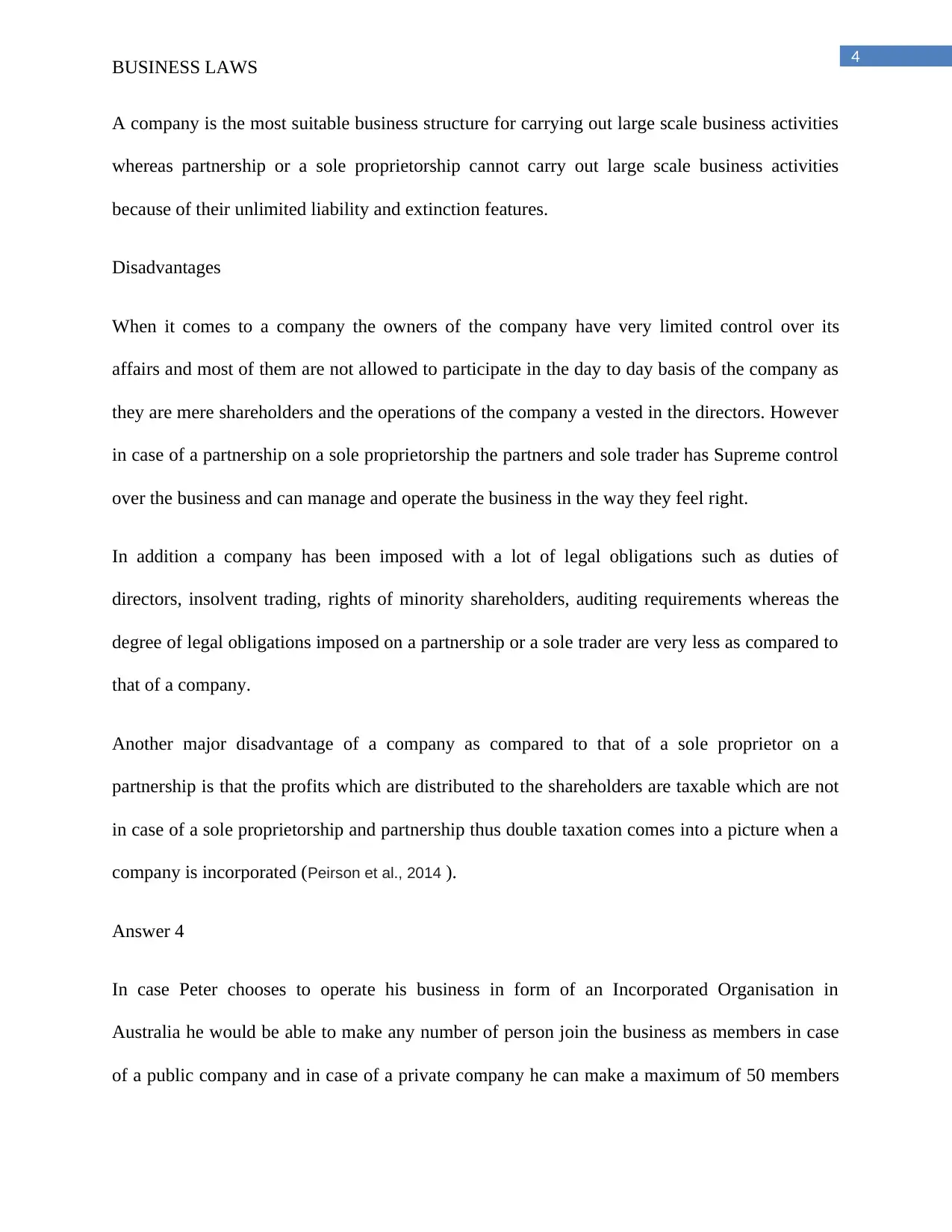
4
BUSINESS LAWS
A company is the most suitable business structure for carrying out large scale business activities
whereas partnership or a sole proprietorship cannot carry out large scale business activities
because of their unlimited liability and extinction features.
Disadvantages
When it comes to a company the owners of the company have very limited control over its
affairs and most of them are not allowed to participate in the day to day basis of the company as
they are mere shareholders and the operations of the company a vested in the directors. However
in case of a partnership on a sole proprietorship the partners and sole trader has Supreme control
over the business and can manage and operate the business in the way they feel right.
In addition a company has been imposed with a lot of legal obligations such as duties of
directors, insolvent trading, rights of minority shareholders, auditing requirements whereas the
degree of legal obligations imposed on a partnership or a sole trader are very less as compared to
that of a company.
Another major disadvantage of a company as compared to that of a sole proprietor on a
partnership is that the profits which are distributed to the shareholders are taxable which are not
in case of a sole proprietorship and partnership thus double taxation comes into a picture when a
company is incorporated (Peirson et al., 2014 ).
Answer 4
In case Peter chooses to operate his business in form of an Incorporated Organisation in
Australia he would be able to make any number of person join the business as members in case
of a public company and in case of a private company he can make a maximum of 50 members
BUSINESS LAWS
A company is the most suitable business structure for carrying out large scale business activities
whereas partnership or a sole proprietorship cannot carry out large scale business activities
because of their unlimited liability and extinction features.
Disadvantages
When it comes to a company the owners of the company have very limited control over its
affairs and most of them are not allowed to participate in the day to day basis of the company as
they are mere shareholders and the operations of the company a vested in the directors. However
in case of a partnership on a sole proprietorship the partners and sole trader has Supreme control
over the business and can manage and operate the business in the way they feel right.
In addition a company has been imposed with a lot of legal obligations such as duties of
directors, insolvent trading, rights of minority shareholders, auditing requirements whereas the
degree of legal obligations imposed on a partnership or a sole trader are very less as compared to
that of a company.
Another major disadvantage of a company as compared to that of a sole proprietor on a
partnership is that the profits which are distributed to the shareholders are taxable which are not
in case of a sole proprietorship and partnership thus double taxation comes into a picture when a
company is incorporated (Peirson et al., 2014 ).
Answer 4
In case Peter chooses to operate his business in form of an Incorporated Organisation in
Australia he would be able to make any number of person join the business as members in case
of a public company and in case of a private company he can make a maximum of 50 members
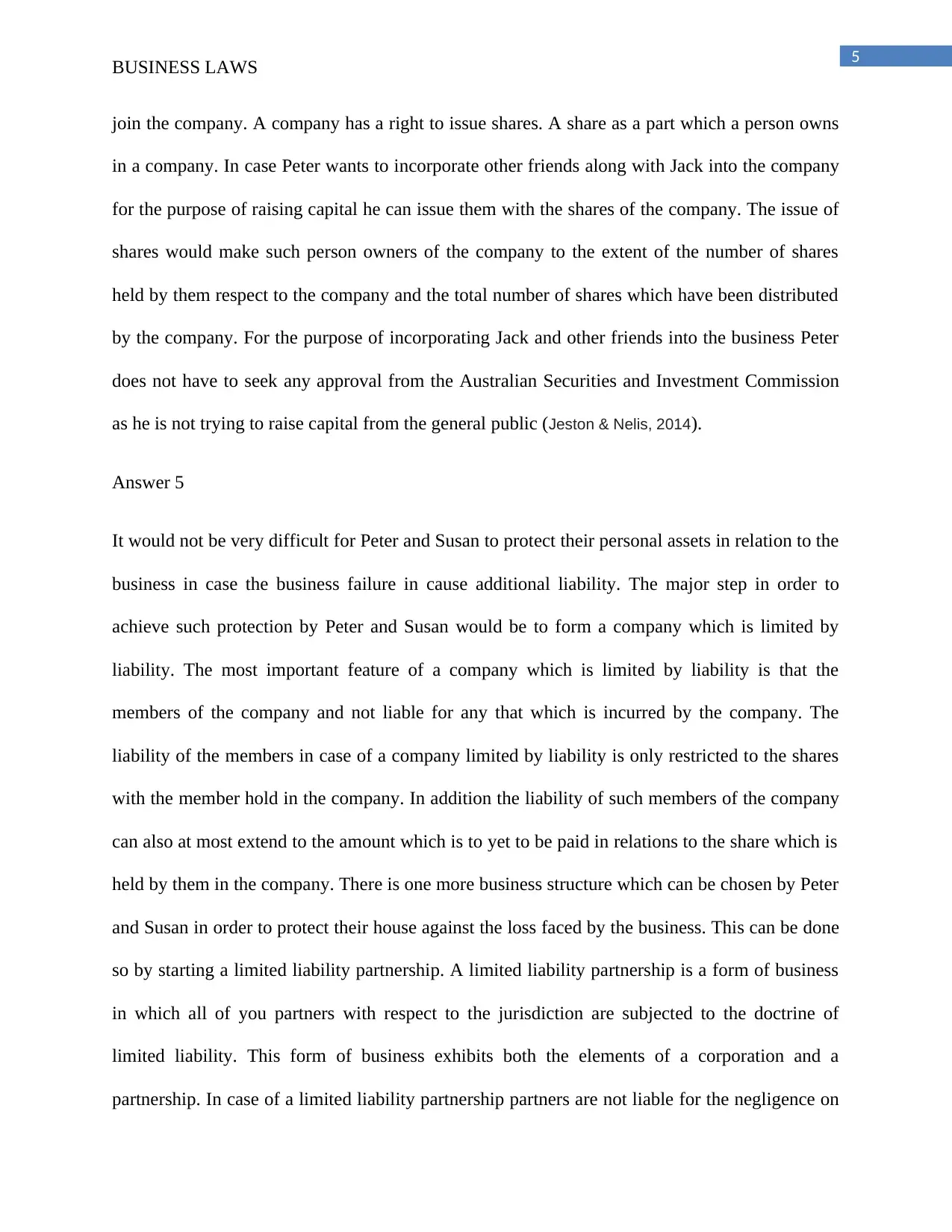
5
BUSINESS LAWS
join the company. A company has a right to issue shares. A share as a part which a person owns
in a company. In case Peter wants to incorporate other friends along with Jack into the company
for the purpose of raising capital he can issue them with the shares of the company. The issue of
shares would make such person owners of the company to the extent of the number of shares
held by them respect to the company and the total number of shares which have been distributed
by the company. For the purpose of incorporating Jack and other friends into the business Peter
does not have to seek any approval from the Australian Securities and Investment Commission
as he is not trying to raise capital from the general public (Jeston & Nelis, 2014).
Answer 5
It would not be very difficult for Peter and Susan to protect their personal assets in relation to the
business in case the business failure in cause additional liability. The major step in order to
achieve such protection by Peter and Susan would be to form a company which is limited by
liability. The most important feature of a company which is limited by liability is that the
members of the company and not liable for any that which is incurred by the company. The
liability of the members in case of a company limited by liability is only restricted to the shares
with the member hold in the company. In addition the liability of such members of the company
can also at most extend to the amount which is to yet to be paid in relations to the share which is
held by them in the company. There is one more business structure which can be chosen by Peter
and Susan in order to protect their house against the loss faced by the business. This can be done
so by starting a limited liability partnership. A limited liability partnership is a form of business
in which all of you partners with respect to the jurisdiction are subjected to the doctrine of
limited liability. This form of business exhibits both the elements of a corporation and a
partnership. In case of a limited liability partnership partners are not liable for the negligence on
BUSINESS LAWS
join the company. A company has a right to issue shares. A share as a part which a person owns
in a company. In case Peter wants to incorporate other friends along with Jack into the company
for the purpose of raising capital he can issue them with the shares of the company. The issue of
shares would make such person owners of the company to the extent of the number of shares
held by them respect to the company and the total number of shares which have been distributed
by the company. For the purpose of incorporating Jack and other friends into the business Peter
does not have to seek any approval from the Australian Securities and Investment Commission
as he is not trying to raise capital from the general public (Jeston & Nelis, 2014).
Answer 5
It would not be very difficult for Peter and Susan to protect their personal assets in relation to the
business in case the business failure in cause additional liability. The major step in order to
achieve such protection by Peter and Susan would be to form a company which is limited by
liability. The most important feature of a company which is limited by liability is that the
members of the company and not liable for any that which is incurred by the company. The
liability of the members in case of a company limited by liability is only restricted to the shares
with the member hold in the company. In addition the liability of such members of the company
can also at most extend to the amount which is to yet to be paid in relations to the share which is
held by them in the company. There is one more business structure which can be chosen by Peter
and Susan in order to protect their house against the loss faced by the business. This can be done
so by starting a limited liability partnership. A limited liability partnership is a form of business
in which all of you partners with respect to the jurisdiction are subjected to the doctrine of
limited liability. This form of business exhibits both the elements of a corporation and a
partnership. In case of a limited liability partnership partners are not liable for the negligence on
⊘ This is a preview!⊘
Do you want full access?
Subscribe today to unlock all pages.

Trusted by 1+ million students worldwide

6
BUSINESS LAWS
misconduct conducted by other partners in the course of business. This feature of the limited
liability partnership is the most important feature which has said to be distinguished from a
traditional partnership. In a limited liability partnership partners have limited liability in the same
the shareholders have it in a corporation. However in Australia there must be one person who has
to be a general partner in the business which means that his liability would be unlimited in the
business (Galbraith, 2014).
Answer 6
There are certain reporting obligations which every business has to comply with for operating in
Australia. Firstly businesses lodge a of business Activity Statement for the purpose of operating
in Australia to the Australian Taxation Office in order to report that taxes and make payment.
Individuals of a certain category may also be required to compulsorily lodge a Business Activity
Statement. The Business Activity Statement can be launched by mail, in person or electronically
on a monthly, quarterly or annual basis depending upon the due instalments.
The Financial Service, financial market and corporate regulator of Australia is the Australian
Securities and Investment Commission. Businesses which are operating in Australia have the
duty to make and submit a financial report to the ASIC at the end of every financial year. The
financial reports have to be audited mandatorily. However under certain circumstances a
company may be exempted from financial reporting.
If a company is registered under the Australian Securities Exchange they have to make a
continuous and periodic disclosure. Information in relation to these requirements are provided by
the assets in the listing rules. The financial reporting in relation to the company’s annual
financial report has to be done in accordance with the Australian Accounting Standards as
BUSINESS LAWS
misconduct conducted by other partners in the course of business. This feature of the limited
liability partnership is the most important feature which has said to be distinguished from a
traditional partnership. In a limited liability partnership partners have limited liability in the same
the shareholders have it in a corporation. However in Australia there must be one person who has
to be a general partner in the business which means that his liability would be unlimited in the
business (Galbraith, 2014).
Answer 6
There are certain reporting obligations which every business has to comply with for operating in
Australia. Firstly businesses lodge a of business Activity Statement for the purpose of operating
in Australia to the Australian Taxation Office in order to report that taxes and make payment.
Individuals of a certain category may also be required to compulsorily lodge a Business Activity
Statement. The Business Activity Statement can be launched by mail, in person or electronically
on a monthly, quarterly or annual basis depending upon the due instalments.
The Financial Service, financial market and corporate regulator of Australia is the Australian
Securities and Investment Commission. Businesses which are operating in Australia have the
duty to make and submit a financial report to the ASIC at the end of every financial year. The
financial reports have to be audited mandatorily. However under certain circumstances a
company may be exempted from financial reporting.
If a company is registered under the Australian Securities Exchange they have to make a
continuous and periodic disclosure. Information in relation to these requirements are provided by
the assets in the listing rules. The financial reporting in relation to the company’s annual
financial report has to be done in accordance with the Australian Accounting Standards as
Paraphrase This Document
Need a fresh take? Get an instant paraphrase of this document with our AI Paraphraser
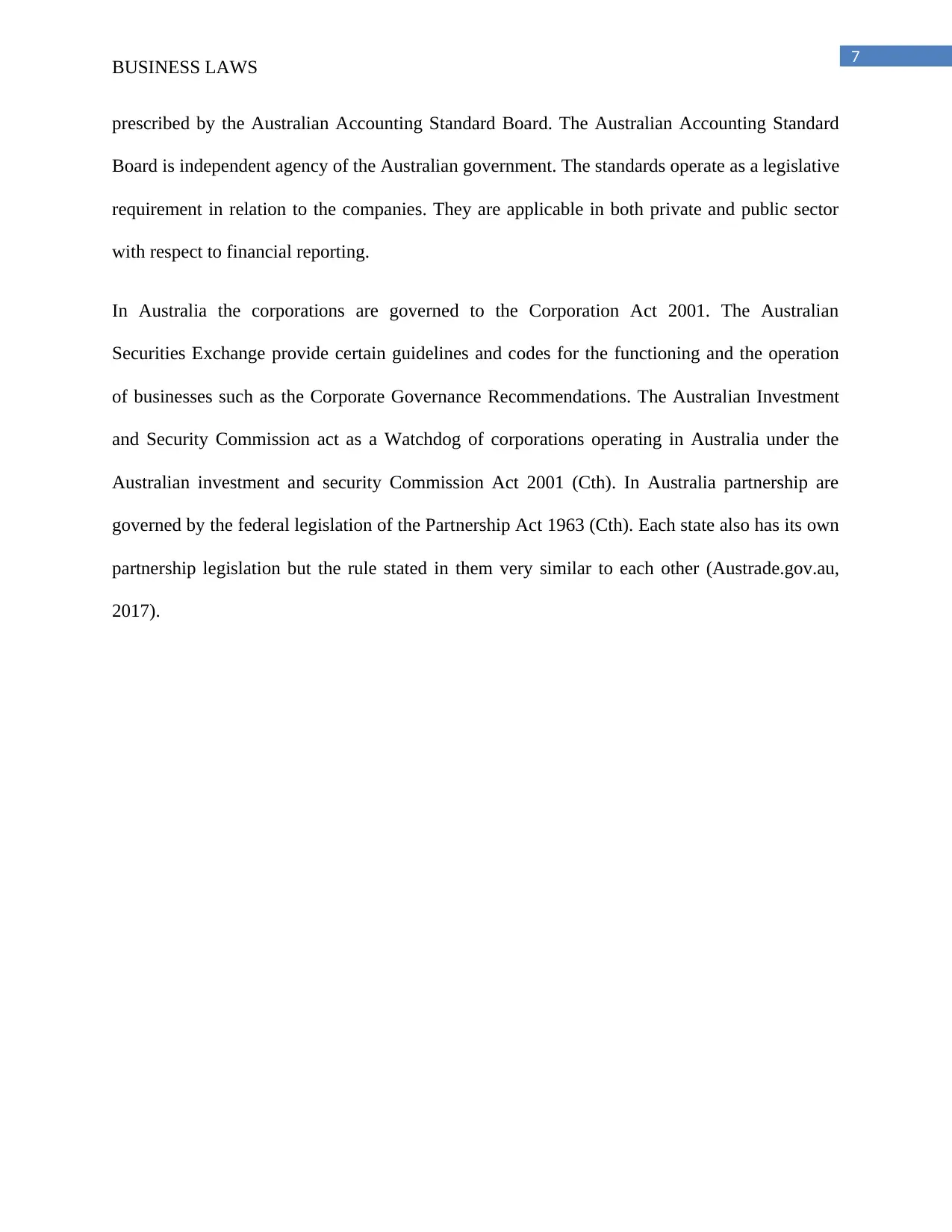
7
BUSINESS LAWS
prescribed by the Australian Accounting Standard Board. The Australian Accounting Standard
Board is independent agency of the Australian government. The standards operate as a legislative
requirement in relation to the companies. They are applicable in both private and public sector
with respect to financial reporting.
In Australia the corporations are governed to the Corporation Act 2001. The Australian
Securities Exchange provide certain guidelines and codes for the functioning and the operation
of businesses such as the Corporate Governance Recommendations. The Australian Investment
and Security Commission act as a Watchdog of corporations operating in Australia under the
Australian investment and security Commission Act 2001 (Cth). In Australia partnership are
governed by the federal legislation of the Partnership Act 1963 (Cth). Each state also has its own
partnership legislation but the rule stated in them very similar to each other (Austrade.gov.au,
2017).
BUSINESS LAWS
prescribed by the Australian Accounting Standard Board. The Australian Accounting Standard
Board is independent agency of the Australian government. The standards operate as a legislative
requirement in relation to the companies. They are applicable in both private and public sector
with respect to financial reporting.
In Australia the corporations are governed to the Corporation Act 2001. The Australian
Securities Exchange provide certain guidelines and codes for the functioning and the operation
of businesses such as the Corporate Governance Recommendations. The Australian Investment
and Security Commission act as a Watchdog of corporations operating in Australia under the
Australian investment and security Commission Act 2001 (Cth). In Australia partnership are
governed by the federal legislation of the Partnership Act 1963 (Cth). Each state also has its own
partnership legislation but the rule stated in them very similar to each other (Austrade.gov.au,
2017).
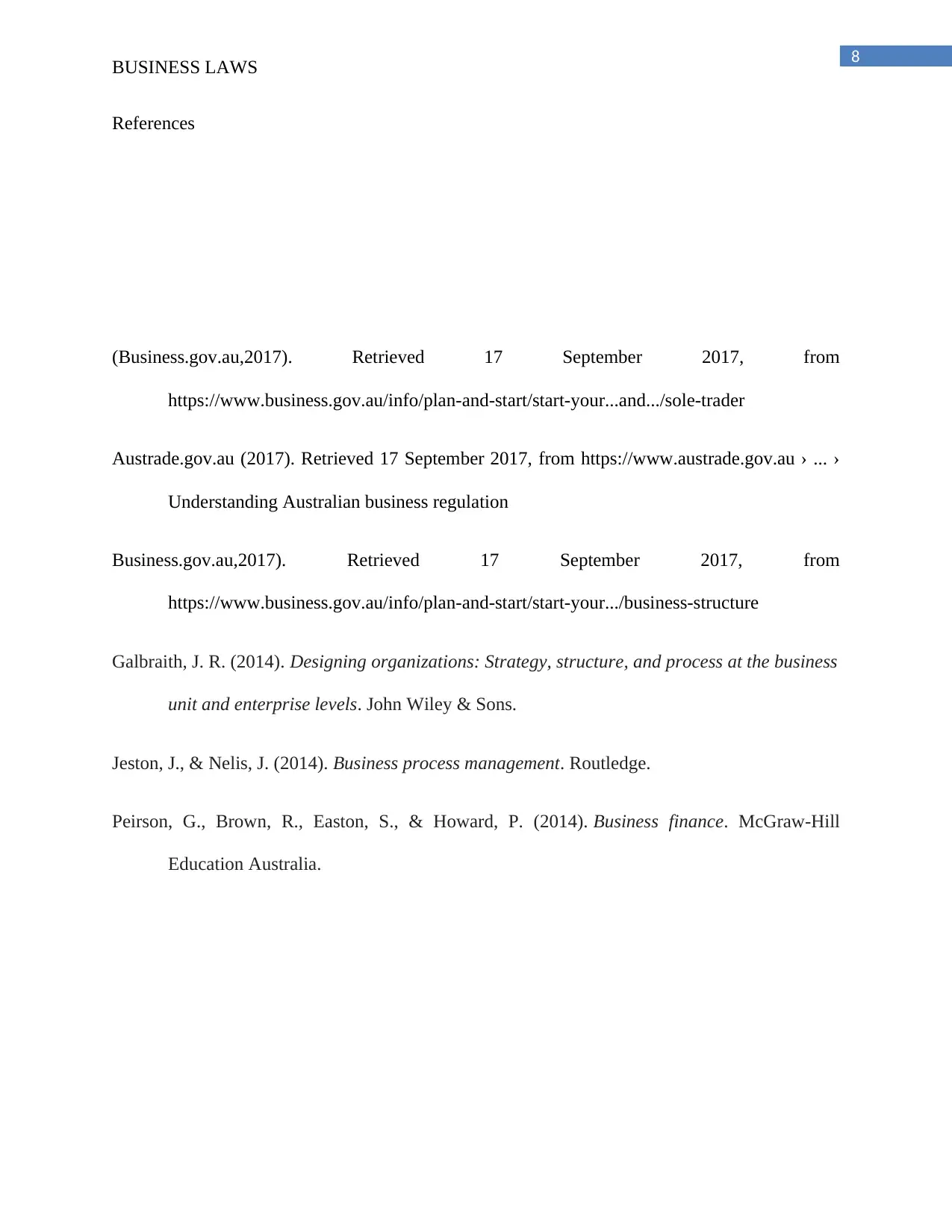
8
BUSINESS LAWS
References
(Business.gov.au,2017). Retrieved 17 September 2017, from
https://www.business.gov.au/info/plan-and-start/start-your...and.../sole-trader
Austrade.gov.au (2017). Retrieved 17 September 2017, from https://www.austrade.gov.au › ... ›
Understanding Australian business regulation
Business.gov.au,2017). Retrieved 17 September 2017, from
https://www.business.gov.au/info/plan-and-start/start-your.../business-structure
Galbraith, J. R. (2014). Designing organizations: Strategy, structure, and process at the business
unit and enterprise levels. John Wiley & Sons.
Jeston, J., & Nelis, J. (2014). Business process management. Routledge.
Peirson, G., Brown, R., Easton, S., & Howard, P. (2014). Business finance. McGraw-Hill
Education Australia.
BUSINESS LAWS
References
(Business.gov.au,2017). Retrieved 17 September 2017, from
https://www.business.gov.au/info/plan-and-start/start-your...and.../sole-trader
Austrade.gov.au (2017). Retrieved 17 September 2017, from https://www.austrade.gov.au › ... ›
Understanding Australian business regulation
Business.gov.au,2017). Retrieved 17 September 2017, from
https://www.business.gov.au/info/plan-and-start/start-your.../business-structure
Galbraith, J. R. (2014). Designing organizations: Strategy, structure, and process at the business
unit and enterprise levels. John Wiley & Sons.
Jeston, J., & Nelis, J. (2014). Business process management. Routledge.
Peirson, G., Brown, R., Easton, S., & Howard, P. (2014). Business finance. McGraw-Hill
Education Australia.
⊘ This is a preview!⊘
Do you want full access?
Subscribe today to unlock all pages.

Trusted by 1+ million students worldwide
1 out of 9
Related Documents
Your All-in-One AI-Powered Toolkit for Academic Success.
+13062052269
info@desklib.com
Available 24*7 on WhatsApp / Email
![[object Object]](/_next/static/media/star-bottom.7253800d.svg)
Unlock your academic potential
Copyright © 2020–2025 A2Z Services. All Rights Reserved. Developed and managed by ZUCOL.




